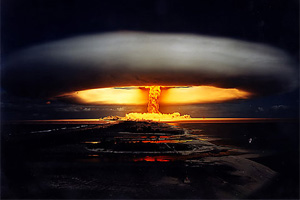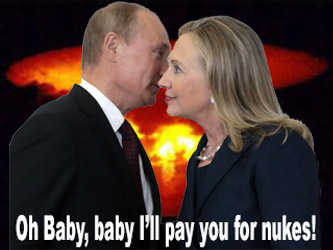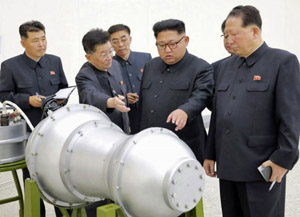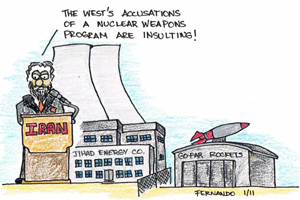
Analysis: On Dec. 9, 2020 Russia conducted a major nuclear forces exercise, firing an ICBM, an SLBM, and cruise missiles, simulating a nuclear war against the United States.
Russian dictator Vladimir Putin personally led the exercise, as is routine for the dictators of Russia, China and North Korea when practicing nuclear combat.
Russia’s nuclear wargame, two days after the 79th anniversary of Pearl Harbor on Dec. 7, was little reported in the U.S. press or noted by Washington officialdom, long accustomed to regarding as routine the simulated annihilation of America.
Nuclear weapons of mass destruction are antithetical to the ethos of democracies that derive their legitimacy from the people. But totalitarian powers celebrate and parade nuclear missiles as symbols of their omnipotence and potential “final solution” to the vexing existence of free peoples, like the United States.

Washington elites — unlike their counterparts in Moscow, Beijing and Pyongyang — regard nuclear war as “unthinkable” much as elites of the Western democracies in the 1930s regarded as “unthinkable” the outbreak of World War II.
Washington and Western elite attitudes, that are mostly far more concerned about “climate change” than deterring nuclear war, replicate the psychology of denial and complacency that made possible the original Pearl Harbor.
Indeed, a Biden administration may unilaterally abolish U.S. ICBMs and nuclear bombers, reducing the U.S. Triad to a Monad of 6-12 ballistic missile submarines — a minimum deterrent posture that could be the final fatal blow to the shrinking credibility of U.S. nuclear deterrence.
Despite President Trump’s heroic efforts to modernize the Triad, the credibility of U.S. nuclear deterrence is in big trouble:

• Nuclear deterrence fundamentals are that the U.S. cannot afford to allow any adversary to achieve real or perceived numerical, technological, or operational decisive advantages. Cold War lessons now seemingly forgotten.
• The U.S. Triad comprises bombers, ICBMs, SLBMs and SSBNs that are decades old, requiring decades to modernize, while Russia, China, and North Korea have mostly new systems, including new delivery vehicles that have no U.S. counterparts, like nuclear-powered cruise missiles, autonomous submarines and hypersonic warheads.
• The U.S. has not tested a nuclear weapon in a quarter-century, has been patching-up old weapons built decades ago that are now long past their original service lives, weapons designed for blast and shock and the antiquated strategic contingencies of the Cold War. Scientists who run the so-called “science-based stockpile stewardship program” warn, without testing, reliability of U.S. nuclear weapons is increasingly doubtful.

• Russia, China, and North Korea, despite the Comprehensive Test Ban Treaty, conduct nuclear tests developing advanced new generation nuclear weapons that have no counterparts in the U.S. deterrent. New Russian nuclear weapons range from 100-megaton doomsday bombs to ultra-low-yield “clean” tactical nuclear weapons for land, sea, and air combat. Even North Korea probably has Super-EMP weapons.
• The U.S. does not even plan or exercise integrated conventional and nuclear operations, having an unrealistic “firewall” between conventional forces and nuclear forces, as if they would not operate together. A 2020 CSIS report warns: “Since the end of the Cold War, the integration of nuclear weapons into conventional war planning has faded as nuclear warfighting has been largely siloed off to USSTRATCOM and separated from the rest of the U.S. military.” Most of the U.S. armed services are not well-educated on nuclear effects or prepared to conduct joint conventional/nuclear operations. In contrast, Russia, China, and North Korea routinely conduct exercises integrating conventional and nuclear forces.
• U.S. and allied top political leaders never conduct military exercises together involving nuclear forces. Would NATO or Pacific allies support U.S. strategic or tactical nuclear use, including U.S. employment of nuclear weapons stored on or launched from allied territory, requiring permission of allied political leaders? Before a nuclear World War III happens, it might be nice to know how Germany’s Angela Merkle, France’s Emmanuel Macron, Italy’s Sergio Mattarella, Belgium’s Charles Michel and NATO’s 23 other members might react in various nuclear scenarios. In contrast, the dictators of Russia, China, and North Korea routinely lead nuclear exercises.

Technological trends — Super-EMP, cyberwarfare, hypersonic warheads, super-accuracy and ultra-low-yield — increasingly favor offensive operations and surprise attack: the much practiced forte of Russia, China and North Korea.
The next administration must give highest priority to deterring a nuclear World War III.
Space-based defenses could work a new revolution in military affairs: making nuclear missiles obsolete; canceling the powerful technological advantages and incentives that presently favor nuclear blackmail and aggression, striking first, and surprise attack; and inaugurating a much safer, more stable era dominated by strategic defenses. The long nuclear nightmare called Mutual Assured Destruction (MAD) could be replaced with the shield of space-based defenses and a new strategic principle — Strategic Assured National Existence (SANE).
SANE would replace the “mutual hostage relationship” of MAD, that threatens destruction of populations, with intercepting the mass destruction weapons that threaten life. SANE and space-based weapons to implement this defensive strategy is consistent with the ethos of democracies and Judeo-Christian “just war” principles, and so should be more popular and politically sustainable than the offensive nuclear capabilities necessary to underwrite MAD.
Americans would rather be protected than avenged.
About the author: Dr. Peter Vincent Pry, director of the Task Force on National and Homeland Security, served as chief of staff on the Congressional EMP Commission, and on the staffs of the House Armed Service Committee and the CIA. He is author most recently of “The Power And The Light” (Amazon.com).
Originally titled “BETTER SANE THAN MAD” and published by the Washington Times Monday Dec. 14, 2020 reprinted with permission from the author.
